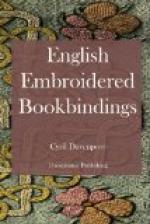Charles I., when he was Prince of Wales, often used the book-stamps that had been cut for his brother Henry, and he also particularly liked the triple plume of ostrich feathers. It occurs, as has been shown, on one of Prince Henry’s velvet-bound books, and it forms the central design on the satin binding of an exquisite manuscript written by Esther Inglis, a celebrated calligraphist, who lived in the seventeenth century. It is a copy of the Emblemes Chrestiens, by Georgette de Montenay, dedicated to Prince Charles, covered in red satin embroidered with gold and silver threads, cords, and guimp, with a few pearls, measuring 11-1/4 by 7-3/4 inches. In the centre is the triple ostrich plume within a coronet, enclosed in an oval wreath of laurel tied with a tasselled knot. A rectangular border closely filled with arabesques runs parallel to the edges of the boards, and there is a fleuron at each of the inner corners. In all cases the design is outlined in gold cord, and the thick parts of the design are worked in silver guimp. There are several spangles, and on the rim of the coronet are three pearls.
New Testament. London, 1625.
One of the most curious embroidered satin bindings still left is now in the Bodleian Library, and a slightly absurd tradition about it says that the figure of David, which certainly is something like Charles I., is clothed in a piece of a waistcoat that belonged to that king.
[Illustration: 38—New Testament. London, 1625.]
It is a New Testament, printed in London in 1625, and covered in white satin, with a different design embroidered on each side. It measures 4-1/2 by 3-1/2 inches. On the upper board is David with a harp. He wears a long red cloak lined with ermine, with a white collar, an under-garment of pale brown, and high boots with spur-straps and red tops. On his head is a royal crown of gold with red cap, and he is playing upon a golden harp. The face of this figure resembles that of Charles I. The red cloak is worked in needlepoint lace, and is in deep folds in high relief. These folds are actually modelled in waxed paper, the needlework being stretched over them, and probably fixed on by a gentle heat. The other parts of the dress are worked in the same way, but without the waxed paper, and the edges of the garments are in some places marked with what might be called a metal fringe, made in a small recurring pattern.
David is standing upon a grass plot, represented by small arches of green purl, and before him is sitting a small dog with a blue collar. Above the dog is a small yellow and black pansy, then a large blue ‘lace’ butterfly, on a chenille patch, and a brown flying bird. Behind David there is a tall conventional lily and a flying bird. The sky is overcast with heavy clouds of red and blue, but a golden sun with tinsel rays is showing under the larger of them. On the lower board is a representation of Abraham about to sacrifice Isaac. Abraham is dressed in a red under-garment on waxed paper, in heavy folds with a belt and edge of stamped-out metal, a blue flowing cape and high boots, all worked in needlepoint lace in coloured silks.




